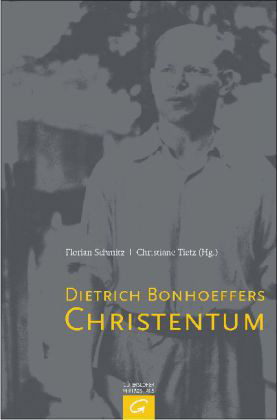ACCH Quarterly Vol. 18, No. 3, September 2012
Review of Florian Schmitz and Christiane Tietz, eds., Dietrich Bonhoeffers Christentum. Festschrift für Christian Gremmels (Gütersloh: Gütersloher Verlag, 2011), 432 Pp. ISBN 978-3-579-07142-8.
By John S. Conway, University of British Columbia
 Dietrich Bonhoeffer must surely be the most discussed and written about theologian in recent German history. His life and thought have brought him a large international following. His praises have been sung continuously in the nearly seventy years since he was murdered. One of the latest contributions is this bilingual collection of essays, written as a tribute to the retiring head of the German section of the International Bonhoeffer Society, Christian Gremmels. He was also one of the main editors of the German edition of the now completed seventeen volumes of Bonhoeffer’s works.
Dietrich Bonhoeffer must surely be the most discussed and written about theologian in recent German history. His life and thought have brought him a large international following. His praises have been sung continuously in the nearly seventy years since he was murdered. One of the latest contributions is this bilingual collection of essays, written as a tribute to the retiring head of the German section of the International Bonhoeffer Society, Christian Gremmels. He was also one of the main editors of the German edition of the now completed seventeen volumes of Bonhoeffer’s works.
Despite the huge amount of both theological and historical discussions of Bonhoeffer’s influence and legacy, there are still some vital questions unanswered. For example, we are still not clear about the exact evolution of his theology from the kind of pious communitarianism as commended in “Discipleship” to the enigmatic “religionless Chrisstianity” of his last prison letters. So too we need to know more about the progress of his political ideas from his early pacifism to his joining the conspiracy to overthrow Hitler by force, and if necessary assassination.
The first half of this book comprises theological essays in both English and German, which shed more light on the above questions. Keith Clements begins with an examination of Bonhoeffer’s sermons preached during his stay on England from 1933 to 1935. He is followed by Bishop Wolfgang Huber’s valuable discussion of “religionless Christianity”. He suggests that it is inadequate to accept one of the more common interpretations of Bonhoeffer’s intentions. In Huber’s view, he did not mean merely the stripping away of the centuries of accretions in both dogma and ritual in order to obtain a purified form of Christianity without “religious” trappings. Rather what Bonhoeffer advocated was the more radical view that, since the world had now come of age, it no longer needed religion of any kind as a means of either interpretation or support. How to declare the love of Christ for such an autonomous humanity is the question Bonhoeffer poses. Huber claims that Bonhoeffer was incorrect in suggesting that “religion” had come to its end point. There is still much evidence of its continuation and validity, even when some forms of Christian witness misuse it for their mistaken sectarian points of view.
On the political side, the Australian scholar, John Moses, pertinently asks the question: “Bonhoeffer was a Revolutionary, but was he a Democrat?” Many commentators have supposed that, since Bonhoeffer so resolutely opposed tyranny, he must have been a democrat at heart. But Moses suggests that, in fact, he shared many of the reservations of his educated bourgeois class against popular sovereignty, which could so easily lead to the kind of demagoguery that Hitler had exploited. But in the opinion of those survivors associated with Bonhoeffer in drawing up plans for a post-war Europe, Bonhoeffer would have had little difficulty in endorsing the kind of political evolution in West Germany after 1949.
More problematic is Bonhoeffer’s role in the attempt to gain support for the resistance conspiracy through his contacts with the churches’ ecumenical movement, most notably through his well-known meeting with Bishop George Bell of Chichester, England in Sweden in 1942. On that occasion he asked Bell—as a member of the House of Lords—to obtain from the British Government some sort of statement supporting the conspiracy in return for a rapid end to the hostilities on the western front. When this project came to nothing, it led some of the resisters to believe that their subsequent failure could be attributed—at least in part—to the Allies’ cold-shouldering of their valiant attempt to overthrow Hitler.
What has never been made clear—and Moses leaves the matter unresolved—is why Bonhoeffer and his friends should have so fully miscalculated the likely response from London, or why he thought Bell had sufficient political influence to succeed in such a task. From today’s vantage point, what stands out is Bonhoeffer’s political naivety. Perhaps it was a matter of the conspirators having so few trustworthy contacts abroad. But the episode surely confirms our impression that any acute political awareness was sadly lacking in the ranks of the Confessing Church.
The latter part of the book contains short personal contributions by a number of Bonhoeffer’s disciples testifying to his continuing inspiration and influence, and ends with an epilogue written by Ruth Alice von Bismarck, the sister of Maria von Wedemeyer, who is now in her nineties. It makes for a heartwarming conclusion.
